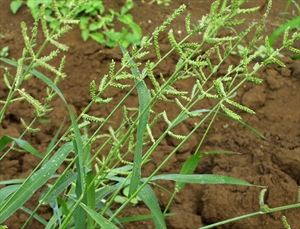- Widespread. Asia, Africa, North, South and Central America, Caribbean, Europe, Oceania. In many Pacific islands.
- Important annual weed of upland and irrigated rice, maize, vegetables, with potential to outcompete native vegetation along waterways, lakes, and swamps, and wetlands. Prefers, moist, heavy, fertile soils, and sun or light shade.
- Shallow-rooted grass, erect or along ground, reddish-purple stems, often branched, 20-60 cm tall. Leaf blades, flat, up to 22 cm long, sometimes with purplish banding. Stems, hairless except at the joints, no outgrowth at blade/sheath junction). Flowerheads, up to 15 cm long, with 5-10 widely-spaced 'spikelets' containing flowers. No bristle at end of spikelets (as in barnyard grass).
- Spread: shoots from stems; seeds by wind, water, animals; animal feed; contaminant of rice seed.
- Biosecurity: high risk of introduction; contaminant of rice seed.
- Biocontrol: little known.
- Cultural control: hand weed up to 2 months; cultivate land (plus use herbicide); increase crop density.
- Chemical control: in Australia: glyphosate. In Fiji, MCPA.





